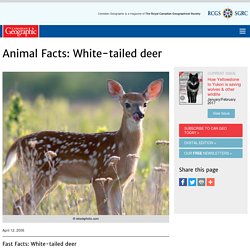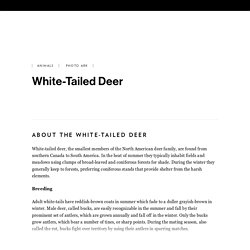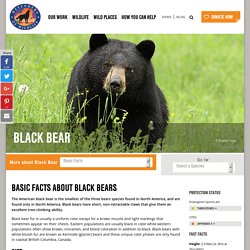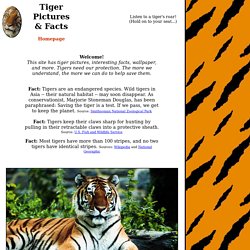

Bald Eagle. Taking Wing Even though a bald eagle is less than 4 feet tall, its wings more than make up for it—they span 5 1/2 to 8 feet!

And these birds know how to use them—a bald eagle can reach a speed of up to 200 miles per hour when diving through the air to grab a meal. These wings are really "in tune," because when a bald eagle loses a feather on one wing, it also loses a matching one on the other wing; this way the bird stays balanced. You may have heard someone say you have "eagle eyes. " You should take it as a compliment, because it means you can see things that others might not notice. Bald eagles are master nest builders. Bald Eagle. Bald Eagle.
Animal Facts: White-tailed deer. Fast Facts: White-tailed deer Scientific name: Odocoileus virginianus Average weight: 68 to 141 kg (male)41 to 96 kg (female)Average height: 68 to 114 cmAverage lifespan: 6 to 14 years (in captivity) Did you know?

The white-tailed deer can make vertical leaps of over two and a half metres and horizontal leaps of nine metres — that’s almost as long as a school bus. Physiology This deer is tan or reddish-brown in the summer and grayish-brown in the winter, with certain areas remaining white all year round. The deer is a great jumper and runner. Like a cow, the white-tailed deer’s stomach has four compartments. Habitats/Behaviours The white-tailed deer is the most common of all of North America’s large mammals. The deer can be active at any time, but is typically nocturnal, which means it is mostly active at night. One unusual characteristic of the white-tailed deer is that the doe leaves her fawn unattended for hours at a time. Range Download a printable version of this page. White-Tailed Deer.
About the White-Tailed Deer White-tailed deer, the smallest members of the North American deer family, are found from southern Canada to South America.

In the heat of summer they typically inhabit fields and meadows using clumps of broad-leaved and coniferous forests for shade. During the winter they generally keep to forests, preferring coniferous stands that provide shelter from the harsh elements. Adult white-tails have reddish-brown coats in summer which fade to a duller grayish-brown in winter. Male deer, called bucks, are easily recognizable in the summer and fall by their prominent set of antlers, which are grown annually and fall off in the winter. Female deer, called does, give birth to one to three young at a time, usually in May or June and after a gestation period of seven months.
White-tailed deer are herbivores, leisurely grazing on most available plant foods. In the wild, white-tails, particularly the young, are preyed upon by bobcats, mountain lions, and coyotes. Basic Facts About Black Bears. The American black bear is the smallest of the three bears species found in North America, and are found only in North America.

Black bears have short, non-retractable claws that give them an excellent tree-climbing ability. Black bear fur is usually a uniform color except for a brown muzzle and light markings that sometimes appear on their chests. Eastern populations are usually black in color while western populations often show brown, cinnamon, and blond coloration in addition to black. Black bears with white-bluish fur are known as Kermode (glacier) bears and these unique color phases are only found in coastal British Columbia, Canada. Diet American black bears are omnivorous: plants, fruits, nuts, insects, honey, salmon, small mammals and carrion. Population It is estimated that there are at least 600,000 black bears in North America. Range The American black bear is distributed throughout North America, from Canada to Mexico and in at least 40 states in the U.S. Behavior Reproduction.
Bear Facts - Species - American Black Bear. The name black bear is not a very accurate name for this species of bear.

They can come in many colors such as black, brown, gray, silvery-blue, and cream. Most black bears are, in fact, black but often a black colored bear will have brown cubs and brown colored bears may have black cubs. The black bear’s habitats range from the far northern tundra of Canada and Alaska to the forests of Central America and Mexico. Fun Tiger Facts for Kids - Interesting Facts about Tigers & Cubs. Tiger Pictures & Facts. Places you can go to help save the tiger: 5 Tigers.org is the ultimate tiger information center on the Internet.

Definitely worth a visit! The Save the Tiger Fund is "dedicated to supporting the conservation of Asia's remaining wild tigers. "The World Wildlife Fund has a very nice website about tigers. They have pictures, conservation information, and ways you can help save the tiger.The Carnivore Preservation Trust is a wildlife sanctuary, that educates the public while saving tigers and other animals that are no longer wanted.Kids for Tigers is a way for children to get involved in helping to save their planet.
This website also has online tiger games and fun activities!